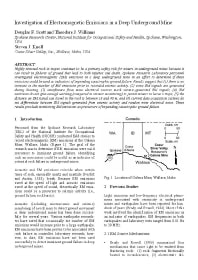Mining Publication: Investigation of Electromagnetic Emissions in a Deep Underground Mine
Original creation date: August 2004
Authors: DF Scott, TJ Williams, SJ Knoll
NIOSHTIC2 Number: 20026118
Proceedings of the 23rd International Conference on Ground Control in Mining, Morgantown, West Virginia, August 3-5, 2004, S.S. Peng, C. Mark, G. Finfinger, S. Tadolini, A.W. Khair, and K. Heasley, eds., Morgantown, WV: West Virginia University, 2004 Aug; :125-132
Highly stressed rock in stopes continues to be a primary safety risk for miners in underground mines because it can result in failures of ground that lead to both injuries and death. Spokane Research Laboratory personnel investigated electromagnetic (EM) emissions in a deep underground mine in an effort to determine if these emissions could be used as indicators of impending catastrophic ground failure. Results suggest that (1) there is no increase in the number of EM emissions prior to recorded seismic activity, (2) some EM signals are generated during blasting, (3) interference from mine electrical sources mask seismic-generated EM signals, (4) EM emissions do not give enough warning (compared to seismic monitoring) to permit miners to leave a stope, (5) the distance an EM signal can travel in the rock is between 18 and 40 m, and (6) current data acquisition systems do not differentiate between EM signals generated from seismic activity and random mine electrical noise. These results preclude monitoring EM emissions as precursors of impending catastrophic ground failure.

NIOSHTIC2 Number: 20026118
Proceedings of the 23rd International Conference on Ground Control in Mining, Morgantown, West Virginia, August 3-5, 2004, S.S. Peng, C. Mark, G. Finfinger, S. Tadolini, A.W. Khair, and K. Heasley, eds., Morgantown, WV: West Virginia University, 2004 Aug; :125-132
- Damage Delineation in Structures Using Laser Vibrometry and Remote Excitation
- Medium-Frequency Propagation in Coal Mines
- Methane-Air Mixtures Ignited by CW Laser-Heated Targets on Optical Fiber Tips: Comparison of Targets, Optical Fibers, and Ignition Delays
- Methods for Determining Roof Fall Risk in Underground Mines
- Modeling and Data Analysis of 50 to 5000 kHz Radio Wave Propagation in Coal Mines
- Performance Characteristics for Welded Wire Screen Used for Surface Control in Underground Coal Mines
- Reducing Control Selection Errors Associated with Underground Bolting Equipment
- Technical Solutions for Enhancements to Mine Safety Using Barricade II Fire Blocking Gel
- Through-The-Earth Wireless Real-Time Two-Way Voice Communications
- Time-Lapse Tomography of a Longwall Panel: A Comparison of Location Schemes